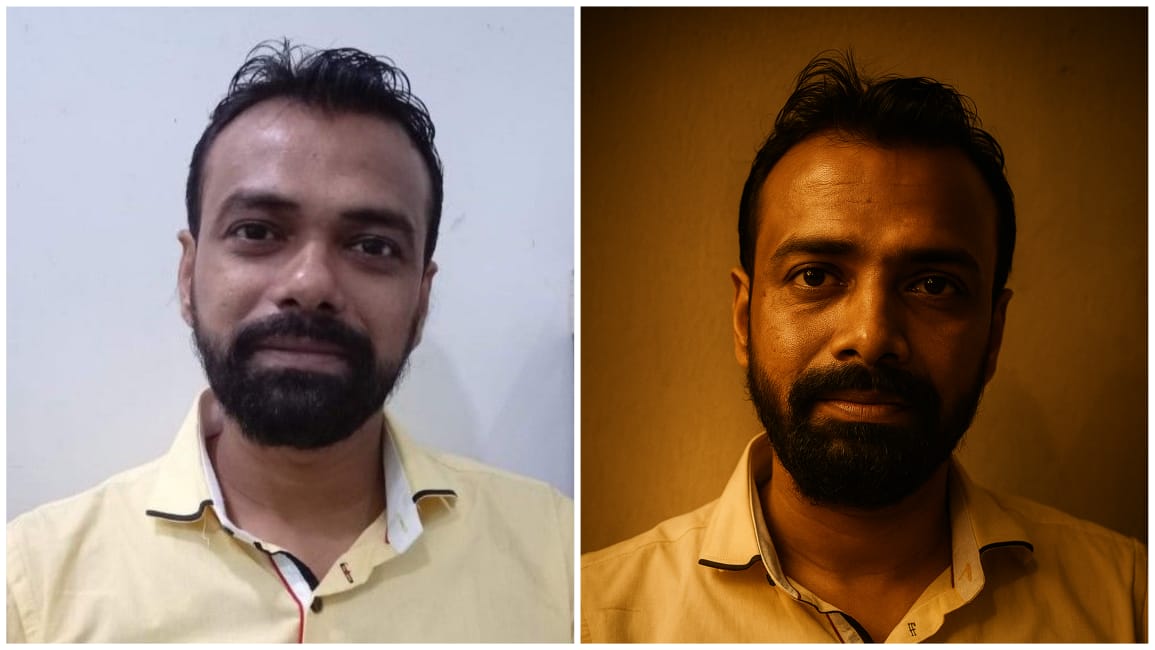You took a normal selfie — maybe inside your room, near a wall, with everyday lighting. Now imagine that same image transformed into a breathtaking golden-hour cinematic portrait… warm sunlight, sharp texture, depth-rich shadows, and eyes that speak. 🔥👁️
In this complete guide, we’ll show you how to transform an ordinary selfie into a high-end, cinematic-style golden-hour portrait using warm tones, 4K texture enhancement, and eye-focused depth — all while preserving your original angle, lighting, and wall background.
This technique is perfect for:
- 📱 Personal branding
- 🎬 Cinematic social posts
- 🎵 Music covers or poster art
- 🎥 Short film thumbnails
- 🧑🎨 Creative portfolios
Let’s start creating some visual magic.
🎯 Understanding the Prompt
Let’s decode the key components:
| Element | What It Means |
|---|---|
| Normal selfie | A standard front-facing photo with casual lighting |
| Golden-hour cinematic portrait | Dramatic light with warm glow, soft shadows, high emotion |
| Maintain original angle & background | No extreme transformation or fake scene |
| Add warm hues | Amber, gold, and orange tones typical of sunset |
| Realistic shadows | Directional shading based on existing light source |
| Fine 4K texture details | High-definition skin, eyes, fabric, etc. |
| Focus on eyes | Make the eyes the emotional anchor of the photo |
This isn’t about turning you into a digital painting. This is about enhancing what’s already there — and elevating it to look like a scene from a movie. 🎞️
🛠️ Tools You Can Use
Desktop:
- Adobe Lightroom Classic
- Adobe Photoshop
- DaVinci Resolve (free version works too!)
- Topaz Photo AI or Gigapixel AI
- Luminar Neo or AI
Mobile:
- Lightroom Mobile
- Snapseed
- Lensa AI
- VSCO
- Remini (for 4K detail upscaling)
AI Art Tools:
- DALL·E 3
- MidJourney v6 or v5.2
- Leonardo.Ai
- Runway ML (for motion/portrait blends)
📷 Step-by-Step: Golden-Hour Cinematic Transformation
🪞Step 1: Choose the Right Selfie
Start with:
- A clear, well-lit image (avoid too dark or overexposed)
- Head and shoulder visible
- Neutral or slight emotional expression
- Visible wall or neutral background
Bonus: If there’s already soft side lighting in your selfie, you’re halfway to golden hour already!
☀️ Step 2: Add Golden-Hour Light
Golden hour = that rich, amber light just before sunset. It hits at an angle and creates cinematic depth.
In Lightroom:
- Temp: +15 to +25
- Tint: +5 (toward magenta)
- Exposure: +0.2
- Shadows: -15
- Highlights: +10
In Photoshop:
- Add a Radial Gradient from side/top corner:
- Color: #f4c87a or #ffd58a
- Blend Mode: Overlay or Soft Light
- Opacity: 30–50%
- Use Photo Filter Adjustment Layer:
- Warming Filter (85)
- Density: 25%
💡 Pro Tip:
To mimic sunlight direction, align golden glow to match your selfie’s lighting angle. If your face is lit from the left, your golden light should fall from the left.
🧱 Step 3: Preserve the Original Background
Many edits completely replace the background — but your prompt says to keep the wall. Here’s how to enhance it instead:
- Add subtle gradient shadow along wall corners
- Apply a color grading layer to wall tones (make them warmer, duskier)
- Increase wall grain or texture slightly to give a raw, film look
Lightroom:
- Use Brush Tool > Apply warmth & dehaze along edges
- Increase clarity & texture on background, not subject
Photoshop:
- Use Selective Color or Hue/Saturation only on the background
- Optional: Add bokeh or light-leak overlay for depth
👁️ Step 4: Sharpen and Highlight the Eyes
The eyes are the emotional anchor in cinematic photography.
In Photoshop:
- Zoom in 200–300%.
- Duplicate eye layer.
- Use Unsharp Mask:
- Amount: 100%
- Radius: 1.2px
- Threshold: 0
- Use Dodge Tool (Midtones, 5%) to add catchlight to iris.
- Add Soft Light layer over iris:
- Light gold for natural warm shimmer.
Lightroom:
- Use the Brush tool around eyes:
- Clarity: +15
- Exposure: +0.2
- Saturation: +5
This pulls the viewer into the subject’s gaze — giving cinematic intensity and storytelling.
🧴 Step 5: Add Fine 4K Texture Details
Now we upscale the realism without making it artificial.
Photoshop:
- Use High Pass Filter (Radius: 2–3px) > Set to Overlay > Apply to texture only
- Or use Topaz Gigapixel AI for actual 4K upscale
- Add skin pore detail manually using frequency separation if needed
Apps:
- Remini or Face Restore AI for skin detail
- Lensa AI Pro Mode (adjust manually, avoid auto smoothing)
Don’t overdo it — keep the natural grain and pores. It should look like high-quality film, not AI plastic.
🖼️ Step 6: Color Grade for Cinematic Mood
Cinematic portraits are all about mood — and golden hour is naturally emotional.
Lightroom:
- Use the Color Grading panel:
- Shadows: Orange-brown
- Midtones: Warm peach or rose
- Highlights: Cream or soft amber
- Add slight vignette (-5 to -10)
- Add grain (10–20%)
Photoshop:
- Use Cinematic LUTs like:
- “Golden Glow”
- “Indie Warm”
- “CineStill 400D”
You can also use Gradient Maps:
- Midtones: #f8c87e
- Shadows: #3b2b1f
- Highlights: #ffe6c0
Set to “Soft Light” or “Overlay” for a movie-grade color scheme.
✂️ Step 7: Crop to Enhance the Scene
Use either:
- 4:3 ratio for traditional portrait feel
- 2.35:1 widescreen crop for cinematic poster feel
Align the subject’s eyes on the top third line, and let light fall from one side.
🔁 Quick AI Prompt Version
Want to generate this instead of editing?
Here’s a universal AI art prompt for MidJourney, DALL·E, Leonardo, etc.:
“Cinematic golden-hour portrait of a person indoors, warm soft sunlight hitting from one side, sharp eye detail, dramatic shadows on wall, preserved selfie angle and lighting, 4K resolution, realistic human skin texture, slightly melancholic expression, 4:3 composition, smooth focus, emotionally cinematic, natural setting, golden tones.”
Modifiers you can add:
- “Wearing hoodie / blazer / shirt”
- “Wall background with subtle grain”
- “Sunset tone, soft lens, film look”
💡 Where to Use This Portrait
- 🎥 YouTube thumbnails
- 🎶 Music cover art
- 📸 Instagram portfolio
- 🧑💼 LinkedIn with cinematic flair
- 🎭 Acting/modeling portfolios
- 🧠 Podcast banners
This isn’t just a pretty photo. It’s a moment frozen in amber light, telling a story beyond the lens.
🧼 Common Mistakes to Avoid
| Mistake | Fix |
|---|---|
| Over-saturation of golden tones | Stick to soft warmth, not neon orange |
| Over-smooth skin | Keep real texture and pores |
| Misaligned lighting | Match original selfie direction |
| Losing focus on eyes | Sharpen and brighten gently |
| Removing wall background | Keep the realism, just enhance |
✅ Final Checklist
| Feature | Done? |
|---|---|
| Warm golden tones | ✅ |
| Eyes highlighted and sharp | ✅ |
| Realistic shadows on wall | ✅ |
| Original selfie angle preserved | ✅ |
| High-resolution 4K texture | ✅ |
| Skin smooth but detailed | ✅ |
| Cinematic grade applied | ✅ |
🎁 Want Ready-to-Use Presets or AI Files?
I can provide:
- 🔧 Lightroom golden-hour preset (.xmp)
- 🎞️ Photoshop LUTs (.cube) for warm cinematic color
- 🎨 AI prompt cards for MidJourney, DALL·E, or Leonardo
- 📷 PSD template with layer masks for glow & wall shadows
Just ask — I’ll package everything into a downloadable ZIP file to speed up your creative process. 🎁✨
🎬 Final Words: Turn Ordinary Into Cinematic Gold
You don’t need perfect lighting or an expensive camera to look cinematic. Sometimes, all it takes is the right tone, a careful shadow, and focused eyes.
Turn your everyday selfies into expressive moments. Let the wall stay as your backdrop. Let the glow fall naturally. Let your eyes speak louder than words.
Because golden hour isn’t just a time of day — it’s a feeling. 🌅📸








